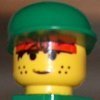I just came across a new method for connection Bionicle 2015 masks to 2x2 round bricks.
The new style of Bionicle masks that came out this year had an odd connection that allowed for them to be flipped off the head as part of an action feature, but this made their connection point rather loose. The heads were less than ideal to squeeze them on, and while you could fit them on technic axle or rod holes, they were often weak or loose.
This new method uses a 2x2 round bricls, which slides in between the two prongs on the back of the mask. And the fit is quite snug, like they were made for each other. The little bumps on the prongs align with the curved edges of the round bring just right. Works with both a smooth round brick and one with ridges. (The one with ridges kind of does a better job locking it radially, so it won't rotate as easily.) On some of the masks, you can also use standard plates to "lock" it in, so it won't slide up or down.
So far, this method works on all the masks, including the six Toa masks, the protector masks, the three villain masks (Skull Spider, Scorpio, and Grinder), as well as the Mask of Creation. The round brick will fit in to all of them, although some have less room to fit in the locking standard plates that I used in the picture above, so some modifications have to be made.
Still, this new method is quite strong, and allows now for easy integration into system. (Plus, the round bricks have axle holes through them, so they can be integrated into CCBS models too.) And when you use transparent round bricks, they shine through as eyes quite well, almost better than the original heads. Plus, there's a larger selection of trans colors to choose from. I have a basic mask stand that relies on socket pieces, but I may need to redesign it to utilize this new method with system bricks.
Anyway, that's what I've got to share for now. (Or maybe I'm just really late to the game on this. I haven't seen this method before, but I'm not following Bionicle MOCs that closely, so maybe I just missed it?)
![]()
-
 5
5




6 Comments
Recommended Comments